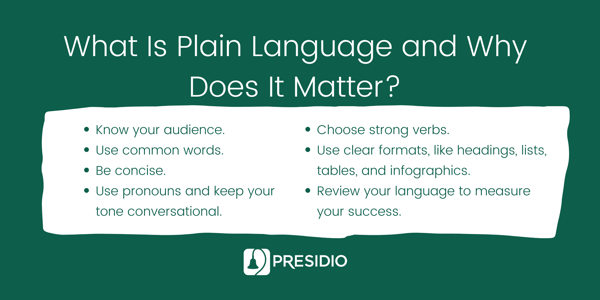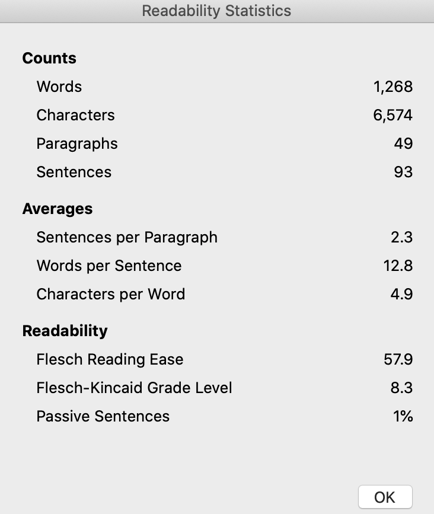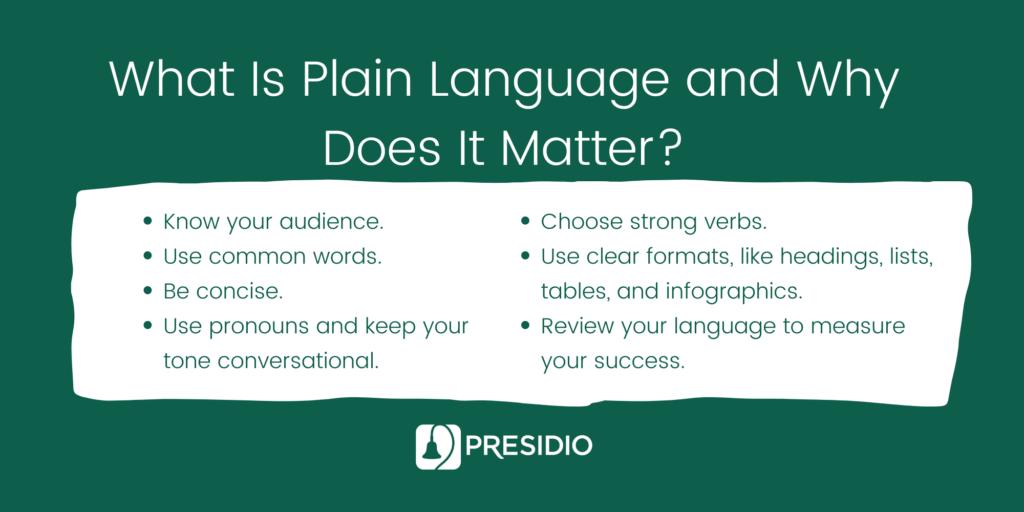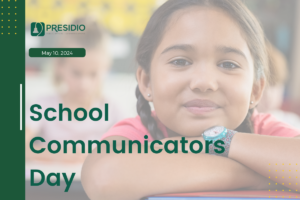How we write is just as important as what we write. This is especially true for government agencies, since they have a duty to keep the public informed, but it really applies to all organizations that produce content for the public and want to keep their audiences engaged.
On the governmental level, the Plain Writing Act of 2010 mandates that federal agencies employ “clear government communication that the public can understand and use.” Of course, advocacy for simple writing existed long before 2010:
.jpg?width=600&name=Plain%20Blue%20and%20White%20Ceramics%20Etsy%20Banner%20(4).jpg)
What qualifies as simple language, or “plain language”? According to the Plain Writing Act, plain language meets the following definition:
“WRITING THAT IS CLEAR, CONCISE, WELL-ORGANIZED, AND FOLLOWS OTHER BEST PRACTICES APPROPRIATE TO THE SUBJECT OR FIELD AND INTENDED AUDIENCE”
As this Act makes clear, plain language is simple, clear, and direct. The most important thing to remember is that plain language is reader-centered. It fulfills three core functions by helping your audience:
- Find what they need.
- Understand what they find.
- Use what they find to meet their needs.
Don’t mistake plain language for “dumbed down” language or for “talking down” to people. Instead, it’s a way of respecting your audience by treating their understanding as your top priority.
So, how can you make sure that your communications follow the best practices for plain language? Here are some general strategies you can use when preparing and reviewing your written materials:

1. KNOW YOUR AUDIENCE.
If you’re writing for an academic journal, then by all means feel free to use technical and complex language. After all, your audience is composed of professional experts who can understand the terminology you’re using. The same is true for professional conferences.
But your audience doesn’t always comprise subject matter experts. You’re often trying to reach people from across all demographics and levels of education. In this case, the more linguistically complex your communications are, the less effective they will be.
Plain language experts suggest that you generally aim for an 8th grade reading level. Why? Studies show that this is about the average reading level for American adults. Also, even highly skilled readers tend to skim public agency communications, especially on digital formats such as websites, email newsletters, or social media platforms.
Remember: write for your reader, not for yourself.
2. USE COMMON WORDS.
Enumerate or count? Remunerate or pay?
Which of the above synonyms strike you as most appropriate for your audience? As a general rule, pick the familiar above the obscure. You don’t want to force your readers to consult Merriam Webster. You can find more helpful word swaps at plainlanguage.gov.
Also, make sure to avoid industry jargon and limit acronyms. You can certainly use familiar acronyms – a user looking through information on the EPA’s website clearly knows what the EPA stands for, and acronyms like FBI and IBM are part of everyday speech.
If you absolutely need to use a less common acronym, though, make sure to include its definition the first time you use it. For example, you can first reference “American Federation of Teachers (AFT)” and then just write “AFT” later in the document.
3. BE CONCISE.
Wordiness is the enemy of clarity. It prevents readers from understanding the information you’re hoping to convey. There are three parts to keeping your writing concise: short words, short sentences, and short paragraphs.
As mentioned above, don’t choose a complex word when a simple word will do. Generally speaking, the fewer syllables a word has, the easier it is to understand.
Shorter sentences are easier to read and process than longer sentences. Even when your ideas are complex, your sentences don’t have to be. Break up each part of your idea into its own sentence. An average of 15-20 words per sentence is a good goal.
Paragraphs are for the benefit of your reader. Cover only one topic in each paragraph and keep your paragraphs short to allow readers to scan easily for the information they need. Looking for some firm numbers? Aim for up to 150 words per paragraph and around 3-8 sentences on average. Feel free to vary paragraph length. There’s nothing wrong with a 2-sentence paragraph following a 5-sentence paragraph.
Finally, white space is your friend! Give your readers’ tired eyes a break.

4. USE PRONOUNS AND KEEP YOUR TONE CONVERSATIONAL.
Even more specifically, use second-person pronouns. Using “you” invites your readers to engage and makes your information more relevant to them. It also helps you avoid awkward, impersonal constructions with “one” or the clunky “he or she,” “his or hers.”
Second-person pronouns also help you develop a conversational – as opposed to institutional – tone. As part of your conversational style, use contractions (“it’s” instead of “it is,” for example), and use concrete examples to help clarify complex concepts.
5. CHOOSE STRONG VERBS.
Strong verbs are the backbone of strong writing. Use present tense when possible, and steer clear of hidden verbs: make sure that you “announce” instead of “make an announcement” and that you “investigate” instead of “conduct an investigation.”
Strong verbs are linked to another key writing choice: active voice over passive voice. Passive voice can sometimes obscure who is responsible for something: “new regulations were proposed.” Active voice, on the other hand, makes clear who does what: “the planning committee proposed new regulations.”
Passive voice isn’t inherently wrong, but try to use it sparingly. For more tips on whether to choose active or passive voice, check out this blog post from Grammarly.
6. USE CLEAR FORMATS, LIKE HEADINGS, LISTS, TABLES, AND INFOGRAPHICS.
Remember that readers scan in order to find the information most relevant to them. Your formatting and design choices can really help them with this.
Headings and lists are great options for clear organization. Tables and infographics can help you present complex information in more easily digestible formats. If you’re worried about dense text, you may want to consider using an if-then table.
You can also use bold, italics, or underline to emphasize important information, but don’t overdo it. If you’re writing in a digital format, though, stick to bold or italics, since readers may expect underlined text to be links.
7. REVIEW YOUR LANGUAGE TO MEASURE YOUR SUCCESS.
Always proofread. Even if you use spell check in Word, Google Docs, or Grammarly, proofreading is essential. It’s usually helpful to get a second set of eyes on your writing as well, so reach out to colleagues to ask them for their input.
Looking for concrete metrics that help you measure your success? Luckily, you can use Flesch-Kincaid readability tests. These come in two forms: the Flesch Reading Ease score and Flesch-Kincaid Grade Level. The formulas for these scores basically depend on word and sentence length.
The Flesch Reading Ease score is on a scale of 1-100, and you should aim for a score of 60 or above. The Flesch-Kincaid Grade Level corresponds to US grade levels of education. As mentioned earlier, you want all communications intended for the general public to be at an 8th grade level.
How can you find out your score? There are free tools available on the internet – such as Online-Utility.org – but you can also enable readability statistics within Microsoft Word.

This is just the start when it comes to plain language, but these 7 strategies can really help your communications achieve the impact you want with your audience. Interested in learning more? Check out the wide range of resources available at plainlanguage.gov.





